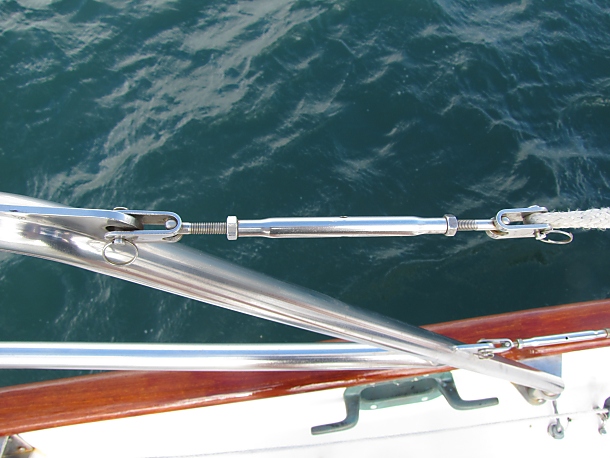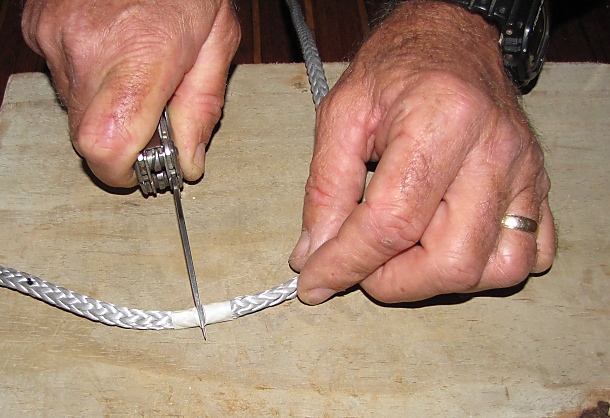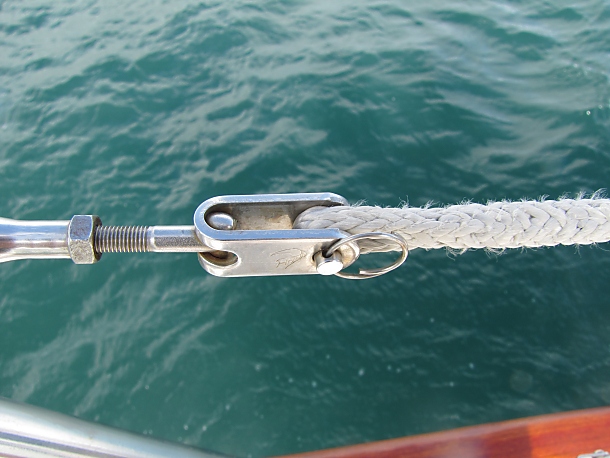The Blue View - Replacing Lifelines with Dyneema Line
/Nine of Cups will soon be celebrating her 28th birthday and has been our home for the last 13 years now. When we moved aboard, she was in pretty good fit, but one thing that needed replacement was the lifelines.
The lifelines on a sailboat act like a fence around the perimeter of the deck. When the boat is pitching and rolling, it gives the sailor something to grab onto and hopefully prevent him or her from being tossed overboard. We replaced the lifelines in the first year we owned Nine of Cups. That time we used stainless 7x7 vinyl coated wire, which looked great for a few years but began showing rust spots after about four years. In year four, we replaced them again using uncoated 7x7 wire which lasted about 5 years.
The next time we investigated using one of the new fiber technologies for our lifelines. These new fibers have a number of properties which make them good candidates for lifelines: high strength, low weight, high resistance to chafe, resistance to flex fatigue, good resistance to UV and very low stretch properties. In addition, they are easy to splice, which means I can make them myself and not have to order premade sections with swage fittings. Before making the decision, however, we needed to do a bit more research. They are called lifelines for good reason, and before we trusted our lives to them, we needed more than the manufacturers' assurance that they would live up to expectations.
After spending hours perusing the various nautical discussion boards (where someone asks a question and then 24 “experts” with varying amounts of actual knowledge provide conflicting answers, all stated with authority, and then argue amongst themselves), we found one very good paper by US Sailing, the national governing body of sailing in the U.S. Their conclusion after considerable research was that, with a few caveats, the new Ultra-High Molecular Weight Polyethylene (UHMWPE) fibers were acceptable for use as lifelines. These UHMWPE fibers have the brand names Dyneema® and Spectra® (referred to below as Dyneema® ).
We decided to use either Amsteel (Samson) or V-12 Vectran (New England Ropes). Both are 12 strand single braid lines with extremely low stretch, high strength and easy splicing characteristics. In addition, both can be ordered in grey, which looks remarkably like steel wire once in place. Both of these lines have the same or higher strength as the equivalent sized wire. The final decision was based on price and availability, and the Amsteel won out.
The project turned out to be quite straightforward and easy to complete. I used about 180 feet of line and the entire project took about 15 hours.
If you are thinking about changing to one of the new UHMWPE fibers, I have a few observations based on our experience.
While the line has a UV resistant coating, it is still susceptible to degradation. Testing has shown that the line will retain 60% of its tensile strength after 5 years of exposure. This loss of strength can be compensated for by using the next larger size line. For example, if 1/4” lifelines are in place, replacing them with 5/16” Dyneema will still retain the equivalent strength for at least five years.
The line has very little stretch, but does exhibit creep. This means over time, the line will slowly get longer. We used turnbuckles in each section so that they could be tightened periodically as needed. Alternatively, one end can be lashed in place, and the lashing shortened occasionally.
The line is chafe resistant, but not totally impervious to chafing. We check ours frequently.
It is quite easy to splice eyes in the ends of the Dyneema. Both Samson and New England Rope have illustrated techniques for eye splices on their websites.
The lifelines should be tensioned so that an 11 pound (5kg) weight hung from the middle of the lifeline does not deflect it more than 2 inches (5 cm).
Our Dyneema lifelines have now been in place for about 4 years, and we are still quite happy with them. The line has a comfortable feel to it and, of course, never rusts. Marcie prefers it to wire lifelines for hanging clothes out to dry on laundry day. It will be time to replace them again in a year or so, and I intend to use Dyneema again.
This is a condensed version of an article that was published in Good Old Boat Magazine in March 2013. The full article goes into more detail on the how-tos of making the lifelines. If you would like a copy of the full article, let us know and we will happily email a copy to you.




